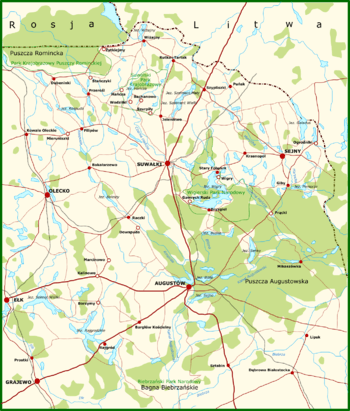Augustów Primeval Forest
Augustów Primeval Forest or Augustów Forest (Polish: Puszcza Augustowska, Lithuanian: Augustavo giria, Belarusian: Аўгустоўская пушча) is a large virgin forest complex located in Poland as well as in northern Belarus and southeastern Lithuania. The forest covers about 1,600 square kilometres (400,000 acres), of which 1,140 square kilometres (280,000 acres) is in Poland.

The Polish part of the forest is located in Podlaskie Voivodeship in northeastern part of the country. The northern part of the Augustów Primeval Forest has been turned into one of the youngest Polish national parks. It was established in 1989, as the Wigry National Park.
History
The former names of the place are Grodno Forest, Perstunskaya Forest. The forest once occupied the territory from Grodno in the southeast to the Baltic Sea in the north.
During the time of the Grand Duchy of Lithuania, the Pushcha was owned by the Grand Duke. He could endow the boyar with a piece of forest, allowing him to create settlements there, to engage in agriculture.
In the direction of the forest was the Slavic colonization of land. Already at the beginning of the XVI century, Ruthenian settlements appeared in the vicinity of the forest, located in the area of the Prussian border. However, the Ruthenian enclaves did not exist there for long and disappeared after the devastating wars of the 17th – 18th centuries.
As the Grodno Forest was cut down and removed from Grodno, the forest became known as the Perstunsky Forest. The name is associated with the area of Crank, which was the administrative center of the local grand duchy. During 1863. uprising many rebels were stationed in this forest. In the Kozi Rinek Reserve there is a rebel cemetery killed in the fight against the armies of the Russian Empire on June 29, 1863. At present, north of Augustow is a monument to these fighters. During the First World War, the forest was severely affected by large-scale felling (about 15% of the forest). According to the 1920, July 12 The peace agreement between Lithuania and Soviet Russia was assigned to the Republic of Lithuania. During World War II, partisans hid in the forest. Also in 1941-1944. the forest was used for executions, during which time about 8,000 people, mostly Jews, were killed in this forest.